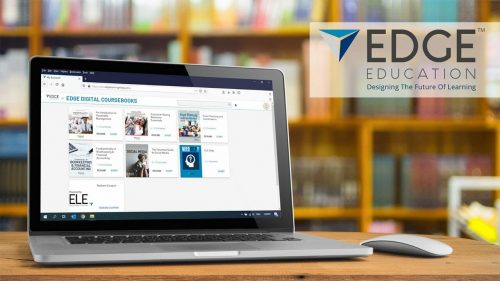When it comes to textbooks, the topic of ‘print versus digital’ is an ongoing debate. Although each person has their preference, there’s no denying that printed materials are somewhat limited in terms of versatility. Digital textbooks, on the other hand, provide both students and educators with more variety in terms of teaching and learning tools, as well as enticing features to improve the learning experience.
A quick online search for the term ‘digital textbook’ yields results that mainly pertain to eBooks. An eBook is an electronic book that contains text and images, is available in a digital format, and is consumed on-screen (e.g. on a computer or mobile device). So, how does a ‘digital textbook’ compare?
Another area to consider is that digital textbooks are becoming increasingly available, and present content in a variety of ways – often, with impressive ‘bells and whistles’. But how do you, as an educator or student, know which features are must-haves, and which ones are merely distractors?
In this article, we’ll discuss four features to look out for, in order to identify a good digital textbook.
1. Interactivity
Both eBooks and digital textbooks mean that the content is accessible on a digital platform. Naturally, this should mean that you can search for a term within the book, with just the click of a button. This saves you from having to scan through hundreds of pages to find what you’re looking for.
A good digital textbook will take this a step further, by also allowing you to search for the meaning of terms from within the book – for example, via reputable online dictionaries such as the Oxford English Dictionary or Merriam-Webster.
Most digital textbooks and eBooks also allow you to highlight and take notes – which are essential features in facilitating knowledge creation. However, some digital textbooks work on a streaming or rental model. Here, a good digital textbook will save your notes even after your access has expired. Additionally, you should be able to extend or renew your subscription, and then access the same version of the textbook with your edits intact.
2. Instructionally designed content
The way we consume content in print versus online formats is not the same – by now, this is a well-established fact. Eye-tracking studies have even shown that eye movements and reading patterns vary quite dramatically when reading on a screen, compared to a printed page.
A good digital textbook publisher will know this, and will compensate via the instructional design of content. In fact, this is one of the major factors that sets digital textbooks apart from both print textbooks and eBooks.
Instructionally designed content is crafted such that it makes the consumption and learning of that content more effective. Put simply, when it is done well, it draws the student in, holds their attention, activates their prior knowledge, presents new information clearly, assists them in applying and integrating this new knowledge, assesses their understanding, and increases their retention of the information learned.
3. Inclusion of multimedia
Many eBooks have been criticised for simply being ‘paper behind glass’. In a multimedia-rich world, their lack of multimedia teaching and learning resources has been listed as a reason for their lack of popularity among students.
Multimedia materials help us pay closer attention to the content, and can include anything from infographics to videos, digital activities, links to additional reading and/or interactive websites, digital quizzes and assessments, and much more. This means that the student is more likely to be engaged and, consequently, more likely to encode the information.
At the same time, various studies have indicated that products with many ‘flashy’ elements are essentially useless, if these elements are irrelevant, unrelatable, and not linked to the content or learning outcomes. A good digital textbook ultimately uses technology and multimedia to complement the learning experience directly, rather than detracting from it.
4. Shared experience
Today, we’re accustomed to using tools that allow us to share our lives on our platforms of choice – and wanting to share aspects of our digital content is no different. In our Age of Experience, real-time experience-sharing plays a central role in connecting us as human beings, rather than simply portraying a ‘virtual self’ online.
Similarly, digital textbooks can both enable and enhance the construction of knowledge, and improve learning, by allowing students to engage with their peers and educators. Some publishers provide for this at a platform level – however, a digital textbook that allows you to communicate and collaborate at a book level, alongside the content being discussed, is what distinguishes it as truly great.
Final thoughts
By ensuring that your digital textbook of choice includes most (if not all) of these important features, both students and educators can maximise the learning experience and increase engagement with the content. Ultimately, the aim is to achieve better results and improved retention of knowledge, so that it can be applied within the workplace.
With these principles in mind, we at Edge Education have crafted our expression of a digital textbook – the EDGE Digital CourseBook. We invite you to take a look via our website or contact us for a demo.
Sources:
Brothen, T. and Wamback, C. (2004), ‘The value of time limits on internet quizzes’. Teaching of Psychology 27: 58–60.
CodeFuel [website] (2015), ‘Tips to Increase User Engagement with Multimedia’. accessed 22 April 2020.
Instructional Design [website] ‘Merrill’s First Principles of Instruction’. accessed 22 April 2020.
Johnson, B. C. and Kiviniemi, M. T. (2009), ‘The effect of online chapter quizzes on exam performance in an undergraduate social psychology course’. Teaching of Psychology 36: 33–37.
Kahla, C. (2019), ‘E-learning is getting a boost with high-quality digital textbooks’. accessed 22 April 2020.
Pebble Design [website] ‘Welcome to the “Experience Age”. accessed 22 April 2020.
TeachThought [website] (2020), ’10 Reasons Students Aren’t Using Digital Textbooks’. accessed 22 April 2020.
The Training Associates [website] (2018), ‘The Benefits of Instructional Design in the Workplace’. accessed 22 April 2020.

